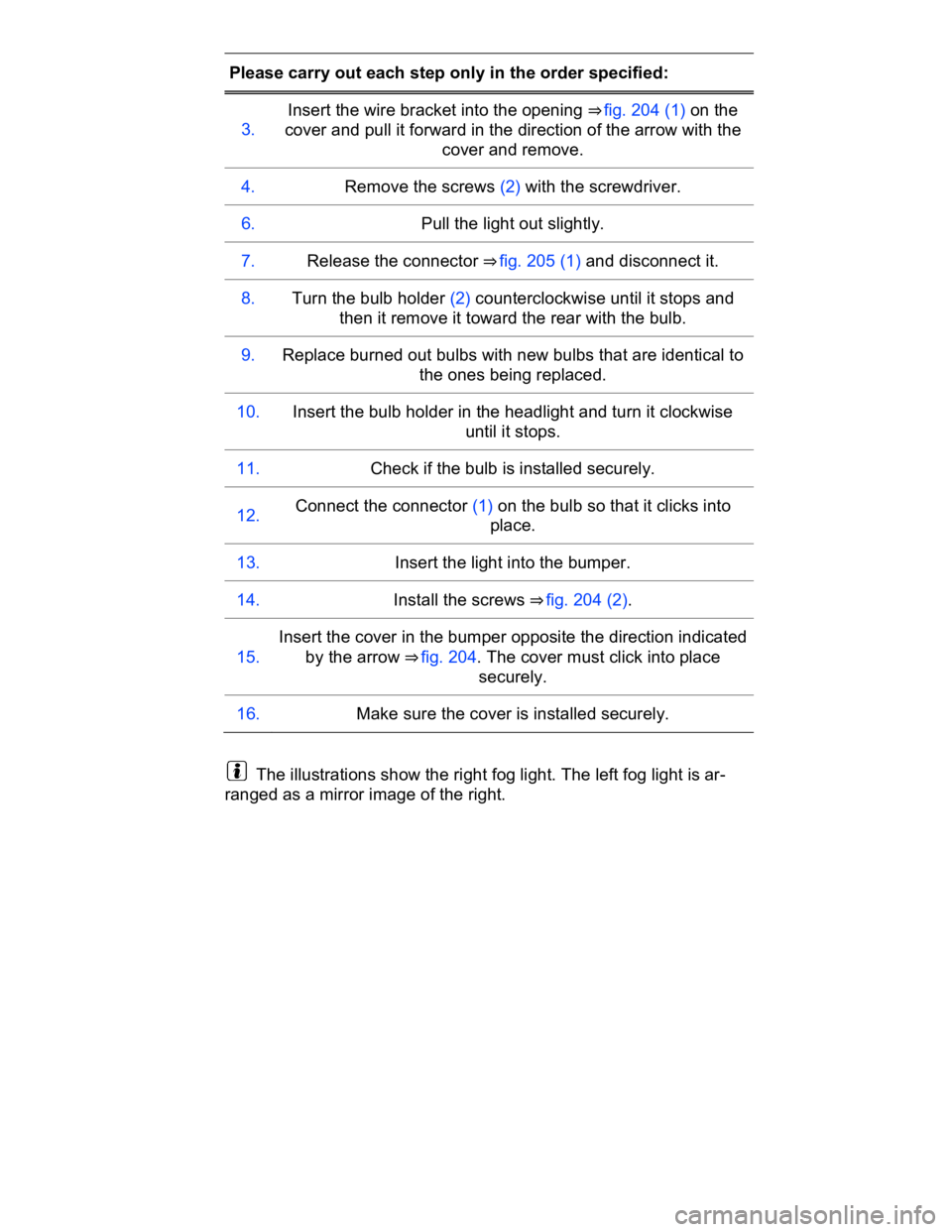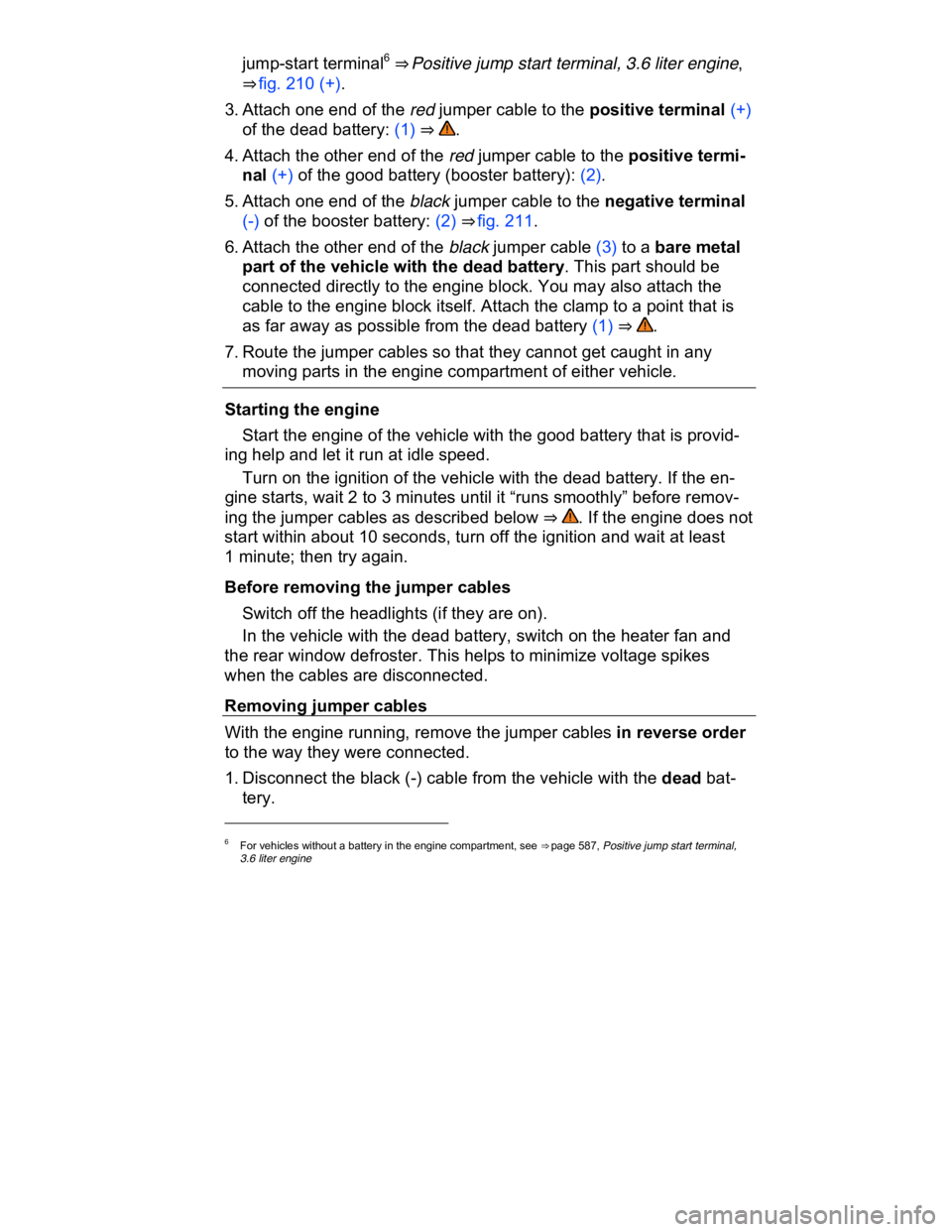Page 555 of 578

Please carry out each step only in the order specified:
3.
Insert the wire bracket into the opening ⇒ fig. 204 (1) on the
cover and pull it forward in the direction of the arrow with the
cover and remove.
4. Remove the screws (2) with the screwdriver.
6. Pull the light out slightly.
7. Release the connector ⇒ fig. 205 (1) and disconnect it.
8. Turn the bulb holder (2) counterclockwise until it stops and
then it remove it toward the rear with the bulb.
9. Replace burned out bulbs with new bulbs that are identical to
the ones being replaced.
10. Insert the bulb holder in the headlight and turn it clockwise
until it stops.
11. Check if the bulb is installed securely.
12. Connect the connector (1) on the bulb so that it clicks into
place.
13. Insert the light into the bumper.
14. Install the screws ⇒ fig. 204 (2).
15.
Insert the cover in the bumper opposite the direction indicated
by the arrow ⇒ fig. 204. The cover must click into place
securely.
16. Make sure the cover is installed securely.
The illustrations show the right fog light. The left fog light is ar-
ranged as a mirror image of the right.
Page 557 of 578
Please carry out each step only in the order specified:
5. Replace burned out bulbs with new bulbs that are identical to
the ones being replaced.
6. Insert the bulb holder in the taillight and turn it approximately
30° clockwise. The bulb holder must click into place.
7. Insert the cover. The cover must lock into place and be se-
cure.
LEDs in the taillights in the luggage compartment lid
LEDs cannot be replaced. Contact your authorized Volkswagen deal-
er or authorized Volkswagen Service Facility for assistance.
Different models may have different lights, and the location and
design of covers, bulb holders, and bulbs may be in a different loca-
tion than shown in the illustrations.
Replacing taillight bulbs in the vehicle body
�
Page 563 of 578

jump-start terminal6 ⇒ Positive jump start terminal, 3.6 liter engine,
⇒ fig. 210 (+).
3. Attach one end of the red jumper cable to the positive terminal (+)
of the dead battery: (1) ⇒ .
4. Attach the other end of the red jumper cable to the positive termi-
nal (+) of the good battery (booster battery): (2).
5. Attach one end of the black jumper cable to the negative terminal
(-) of the booster battery: (2) ⇒ fig. 211.
6. Attach the other end of the black jumper cable (3) to a bare metal
part of the vehicle with the dead battery. This part should be
connected directly to the engine block. You may also attach the
cable to the engine block itself. Attach the clamp to a point that is
as far away as possible from the dead battery (1) ⇒ .
7. Route the jumper cables so that they cannot get caught in any
moving parts in the engine compartment of either vehicle.
Starting the engine
� Start the engine of the vehicle with the good battery that is provid-
ing help and let it run at idle speed.
� Turn on the ignition of the vehicle with the dead battery. If the en-
gine starts, wait 2 to 3 minutes until it “runs smoothly” before remov-
ing the jumper cables as described below ⇒ . If the engine does not
start within about 10 seconds, turn off the ignition and wait at least
1 minute; then try again.
Before removing the jumper cables
� Switch off the headlights (if they are on).
� In the vehicle with the dead battery, switch on the heater fan and
the rear window defroster. This helps to minimize voltage spikes
when the cables are disconnected.
Removing jumper cables
With the engine running, remove the jumper cables in reverse order
to the way they were connected.
1. Disconnect the black (-) cable from the vehicle with the dead bat-
tery.
6 For vehicles without a battery in the engine compartment, see ⇒ page 587, Positive jump start terminal, 3.6 liter engine
Page 568 of 578

WARNING
Never tow a vehicle without any electrical power.
� Never remove the remote control vehicle key from the igni-
tion switch or turn off the ignition with the starter button while
the vehicle is moving. The electronic steering column lock
could suddenly engage, and you would not be able to steer or
control the vehicle. You can lose control of the vehicle, crash,
and seriously injure yourself and others.
� If the vehicle loses power while it is being towed, stop towing
the vehicle immediately and contact your authorized
Volkswagen dealer or authorized Volkswagen Service Facility
for assistance.
WARNING
Towing a vehicle changes the way it handles and brakes. To
help reduce the risk of an accident and serious personal injury,
note the following:
� The driver of the vehicle that is being towed:
– Since the brake booster also does not work when the en-
gine is stopped, you will need to press harder on the brake
pedal to slow down or stop. Always be alert so as not to rear-
end the towing vehicle.
– Will have to use considerably more force to turn the steer-
ing wheel because the power steering is not working.
� The driver of the vehicle that is doing the towing:
– Must accelerate gradually and gently and avoid jerking
movements.
– Must not brake hard or steer sharply.
– Must brake earlier and more gently than in normal driving.
NOTICE
� Be careful not to damage the paint when installing and remov-
ing the towing eye and the cover for the threaded hole behind
the bumper.
Page 570 of 578
electrical system is operating. In the following situations, the vehicle
cannot be towed at all and must be transported on a flatbed truck or
trailer:
� If the front and rear wheels cannot turn.
� If the vehicle battery is dead (because the electronic steering col-
umn lock engages and cannot be released).
� If you have to tow an automatic transmission vehicle more than
30 miles (50 km).
WARNING
It is not safe for children or other persons to ride in a vehicle
that is being towed.
� Never let children or anyone else remain in the vehicle while
it is being towed.
NOTICE
The drive axle rotates while the vehicle is being towed with its
rear wheels off the ground. This can damage the automatic
transmission.
� Never tow automatic transmission vehicle with the rear wheels
off the ground.
� Tow manual transmission vehicles with the rear wheels off the
ground only if it is certain that no transmission fluid can leak
out.
Tips on towing
�
Page 572 of 578

When not to tow your vehicle
In the following situations, the vehicle cannot be towed and must be
transported on a flatbed truck or trailer:
� If transmission fluid has leaked out of the transmission.
� If there is little or no oil in the transmission because of damage to
your vehicle, it must be moved with the drive wheels off the ground.
� If the front and rear wheels cannot turn.
� When the vehicle battery is dead, because the steering may remain
disabled and it may not be possible to release the electronic steering
column lock. If the electronic parking brake was engaged when the
battery died, it cannot be released.
� If you have to tow an automatic transmission vehicle more than
30 miles (50 km).
Towing other vehicles
� Obey all legal requirements
� Read and heed all towing information in the owner's manual for the
other vehicle.
A vehicle can be towed only if the electronic parking brake and
the electronic steering column lock are released. In case of a power
loss or malfunctions of the electrical system, the engine may have to
be jump-started ⇒ Jump-starting in order to release the electronic
parking brake and the electronic steering column lock.
Installing the front towing eye
Fig. 212 In the right front bumper: Removing the cover cap.
Page 575 of 578
� Screw the towing eye counterclockwise into the threaded hole as
far as it will go ⇒ fig. 215 ⇒ . Use the lug wrench to turn and tighten
the towing eye.
� When towing is complete, unscrew the towing eye clockwise to
remove it.
� Position the bottom of the cover in the opening in the bumper and
carefully push the top of the cover over the edge of the opening.
� Push on the cover until it locks into place.
NOTICE
Always make sure the towing eye is screwed all the way into
threaded hole so that it is secure. If not, it could be pulled out
while your vehicle is being towed.
Driving tips while towing
�
Page 577 of 578
Abbreviations
Abbreviation Meaning
ABS Anti-lock Brake System
AFS Adaptive Front Lighting System
AKI Anti-Knock Index
ANSI American National Standards Institute
ASR Anti-Slip Regulation
ATA Anti-Theft Alarm system
BAS Brake Assist System
ccm Cubic centimeter – metric unit of measure for engine
displacement
CCS Cruise Control System
CID Cubic inch displacement – unit of measure for engine
displacement
cm Centimeter – metric unit of measure for length
CO2 Carbon dioxide
DIN Deutsches Institut für Normung (German Institute for
Standardization)
DRL Daytime Running Lights
DSG® Direct Shift Gearbox automatic transmission
EDL Electronic Differential Lock
EN European Norm
EPC Engine control (Electronic Power Control)
ESC Electronic Stability Control
g/km Generated carbon monoxide amount in grams per
kilometer driven
GAWR Gross Axle Weight Rating
GVWR Gross Vehicle Weight Rating
HID High Intensity Discharge headlights (Xenon)